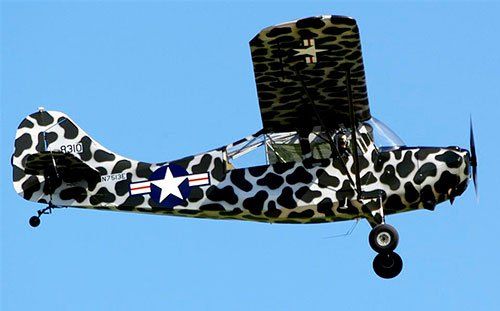Aeronca L-16
The L-16 is a high wing, single engine, fabric covered, conventional gear, 2 seat monoplane. It was manufactured by the Aeronca (Aeronautical Corporation of America) in Middletown, Ohio. The civilian version that started the military L-16 versions was designated 7BCM. There were two military variants of the L-16; L-16A and L-16B. It was nicknamed the Grasshopper.
Production of the 7BCM started in 1947. Virtually the entire production of the 7BCMs was purchased by the military as the L-16A. The L-16A featured an upgraded engine, the Continental O-190 (military designation for the Continental C85). This engine produced 85 horsepower. Shortly after the L-16A came off of the production line, the aircraft was upgraded to a Continental o-205-F (military designation for the Continental C90) producing 90 horsepower.
The specifications for both variants are:
Weight: Empty 870 lbs., Max Takeoff 1,300 lbs.
Wing Span: 35ft. 1.75in.
Length: 21ft. 5.75in.
Height: 7ft. 0in.
Performance
Maximum Speed: 135 mph
Ceiling: 12,000 ft.
Range: 400 miles
Armament: None
History
The L-16's forerunner, Aeronca L-3, saw extensive use in World War II as a observation/artillery spotter, general utility and rescue. When the L-3 was upgraded and became the L-16, its mission did not change where it saw extensive use in the Korean War.
After WWII and the Korean War, the L-16 returned to civilian life as an Aeronca 7BCM. With a change of paint from the military OD to civilian colors, the L-16 became very popular in General Aviation as a flight trainer teaching primary students flying. Many of the L-16/7BCMs were given the Civil Air Patrol.
Aeronca L-16B Replica Restoration of N7513E: THE STORY OF SPOT,
By Steve Nuwer
I've heard it said that some are born into greatness and others achieve it through hard work and dedication. But I also believe there are those who stumble into the limelight through luck or happenstance. The latter is how I describe the life and journey of 7513E.
Let me begin by acknowledging that the subject of this story is not an ex-military Aeronca L-16B, but rather a replica of the revered L-16. And not just any replica, but probably one of the least likely candidates for such a project, having started life as
a 1958 American Champion 7FC. What's a 7FC you ask? None other than the venerable Tri-Champ. Sharp-eyed observers quickly pick up on the squared wingtips, landing lights, hydraulic brakes and extended cowling, needed for electric starter clearance between the C-90-12F and firewall, but most fixate on the unusual camouflage scheme never realizing its' civilian origins.
13E began as a flying school hack in Pennsylvania and logs show two taxiing accidents resulting in major repairs. After the second accident, 13E was converted in 1964 to "7EC" configuration by removing the nose gear, relocating the main gear and adding a tailwheel, thus beginning its' long journey to becoming an L-16. Passing through several owners, 13E was acquired by the late Bob Beckman and converted to L-16 appearance by adding the rear greenhouse structure and olive drab paint in 1984. Flown for many years in the olive drab motif, 13E became a familiar sight at mid-America air shows and fly-ins as part of the "Wrong Brother's Air Force" until purchased by Larry Kelley's Ragwings and Radials organization in 1996.
I was first introduced to 13E while a volunteer laborer on Larry's B-25 "Panchito". I must admit that it was not love at first sight and compared to the B-25 with its' acres of polished aluminum and R-2600s, the little Champ in it's worn olive drab attracted hardly a glance. Then, in another strange twist of fate, 13E was bent in an off-runway accident in the late Summer of 1998. A survey of the airframe revealed the most serious damage to be a cracked wing spar, bent lift struts and a bent propeller. Due to the age of the fabric, the decision was made to completely recover the airframe. My brother Paul, who at the time had just graduated to left seat in the B-25, volunteered to repair and recover the wounded Champ at his private air strip. He assembled a respectable team of volunteers, including myself, to help using the tried and true Tom Sawyer method of describing how much "fun" it would be. Well, it did turn out to be a lot of fun, and not just the countless hours spent cooped up in the hangar with open containers of Poly-Fiber, but some new friendships were forged along the way.
From day one, Larry had the idea to recreate an unusual field-applied camouflage scheme applied to some of the few L-16s that served in Korea during the first year of combat. As the story goes, all L-16s were supplied in standard overall silver, of which approximately 100 were shipped to Korea in 1950 for use in liaison and artillery spotter duties. Upon arrival at the front lines, it was quickly realized these bright little airplanes and their crews wouldn't survive long without some form of camouflage, so olive drab was quickly applied using anything available, including rags, sponges and mops, giving them a unique green-over-silver color scheme.
The problem was, we could locate only one photo of a camouflaged L-16A..in flight.and it was a very poor quality photo. With limited documentation, but a strong desire by Larry, we forged ahead against our better judgment and began applying olive drab "spots" over the beautiful and fresh silver. Basically, the olive drab "spots" consist of 4 template shapes cut out of cardboard, each with a name describing its' shape or "personality". For example, one was the "amoeba", another was the "kidney", and others were named for parts of the male human anatomy that are probably best not repeated here. While the template names were certainly functional, (the painter would call out which shape he wanted next by name), they also added to the entertainment factor. I cannot fully describe the amount of time. tedious time, required to apply the camouflage and we often joke it took longer to apply the spots than it did to re-cover the airplane!
Finally, with the camouflage completed and airframe assembled, nicknames began surfacing almost immediately, including "Army Cow" and a few less flattering. But the one that stuck was simple, affectionate and appropriate. Coined by Col. Bob Fryer at a Portsmouth-Hampton Roads VA air show, 13E is simply known as "Spot".
Toward the final stages of the rebuild, I regained my currency after a fifteen year absence from flying. What started out for me as an unglamorous and often ignored airplane grew into a real appreciation for the type to which was added the significance of missions performed during the early months of the Korean War. Although I had some time in Citabrias, I found N7513E to have a completely different, almost a subdued personality however there was a distinct familiarity and the bloodlines were evident. Most important was my realization that this airplane was fun. No, it isn't fast, (cruise is in the range of 82-83 kts), and it doesn't climb like a real L-16, (the extra 200 lbs of electrical equipment and a cruise prop limits the climb rate), but it is an honest airplane that really doesn't have any bad habits or characteristics.
One of the friendships forged from the re-covering effort was with Tony Markl of Marydel, Maryland. Tony was an Ex-Air Force Captain having flown B-47s and B-52s in SAC, Skyraiders in Vietnam and taught tailwheel skills in a restored 1947 L-16A. Tony was also an artist and master at the Poly Fiber aircraft covering technique. Tony's advice and experience during the recovering process began the acquaintance, but Spot helped form our friendship. After attending a few air shows with Spot during the 2000 and 2001 season, Tony approached me about my interest to learn formation flying. Yes, I was apprehensive at first.after all, how do you learn formation skills except to start flying two airplanes close? Well, I couldn't have been more surprised and relieved at Tony's methodology; an interesting combination of Air Force training, his own logical mindset and the J.L.F.C. doctrine. We began slowly, continued to practice and in December 2002, I took my check ride and qualified for my Formation Wing Card. More than just something to do, formation flying is challenging, especially in a low-powered high wing airplane with a light wing loading. Not only has the formation training and practice improved my flying skills beyond what my logbook hours reflect, it has brought a lot of fun back into flying.
Since first arriving in pieces, N7513E has resided at a private airstrip in Hurlock, MD and continues to fly regularly from this grass strip. In fact it is the only airplane that resides there, enjoying a large hangar all to itself that was previously occupied by ag-aircraft. And it no longer lives in the shadow of Panchito, although they do attend air shows together, N7513E enjoys its' own spotlight now. Regardless of how it got there, Spot is now home.
The rebuild of N7513E certainly would not have been possible without the enthusiasm and support of Larry Kelley, the facilities of Paul Nuwer and a mixed bag of volunteers including Tony Markl, Harry Fox, Dean Caputo, Bobby Snead and Tim Stagg. Their efforts are appreciated and will continue to be displayed at air shows in and around the central Mid-Atlantic region for all to enjoy. For more photos, information and air show schedule of Spot, Panchito and the UC-78 Bobcat, visit http://delawareaviationmuseum.org.


